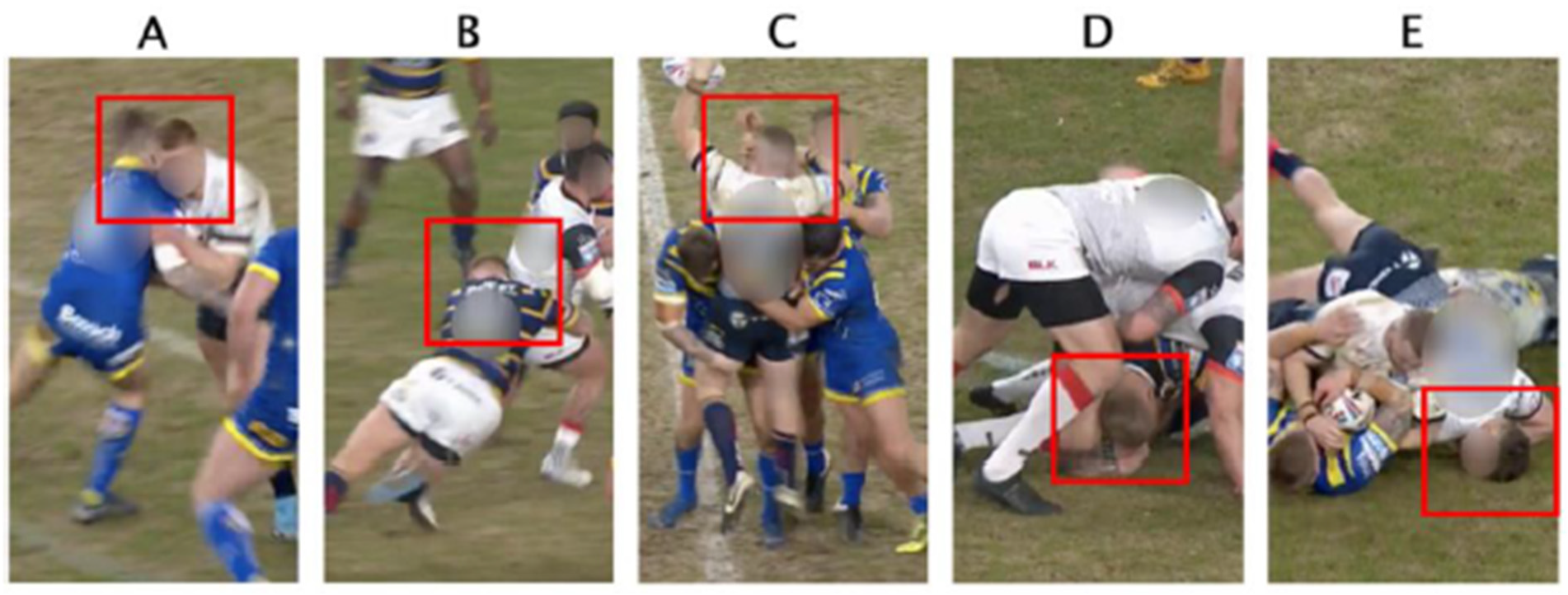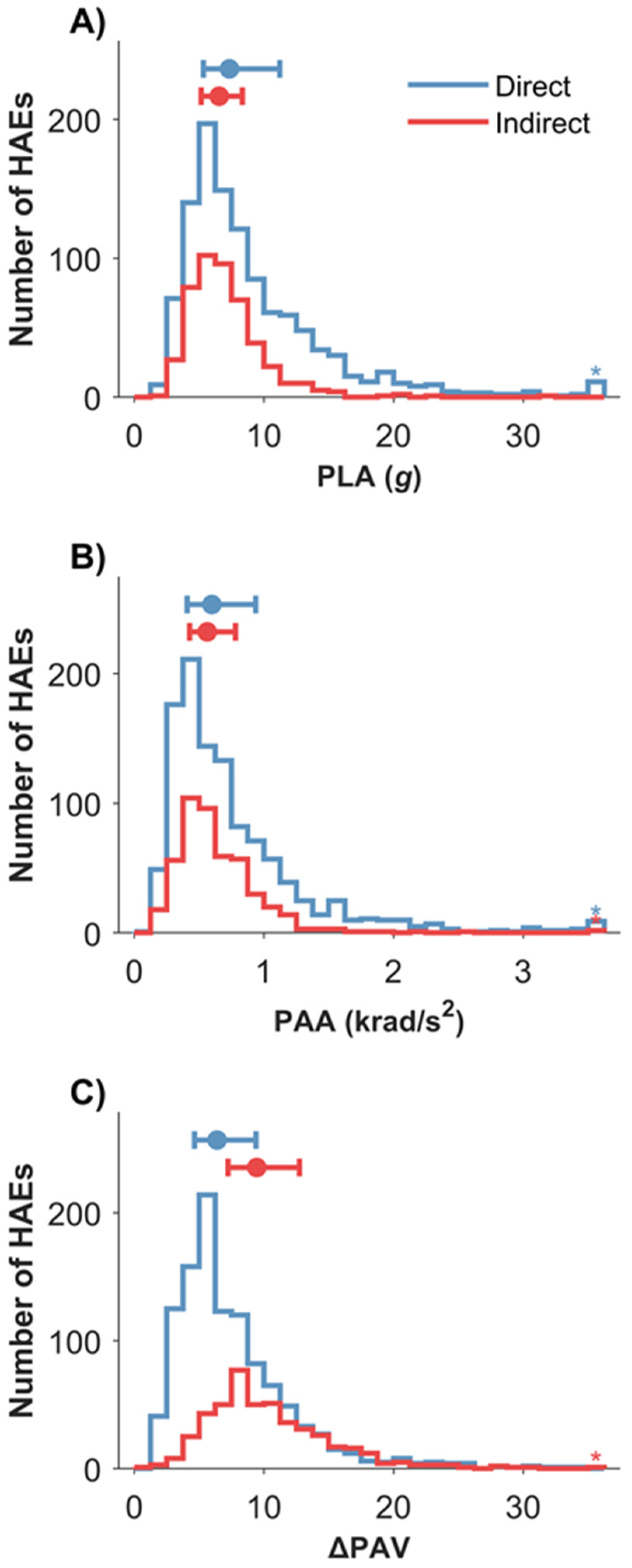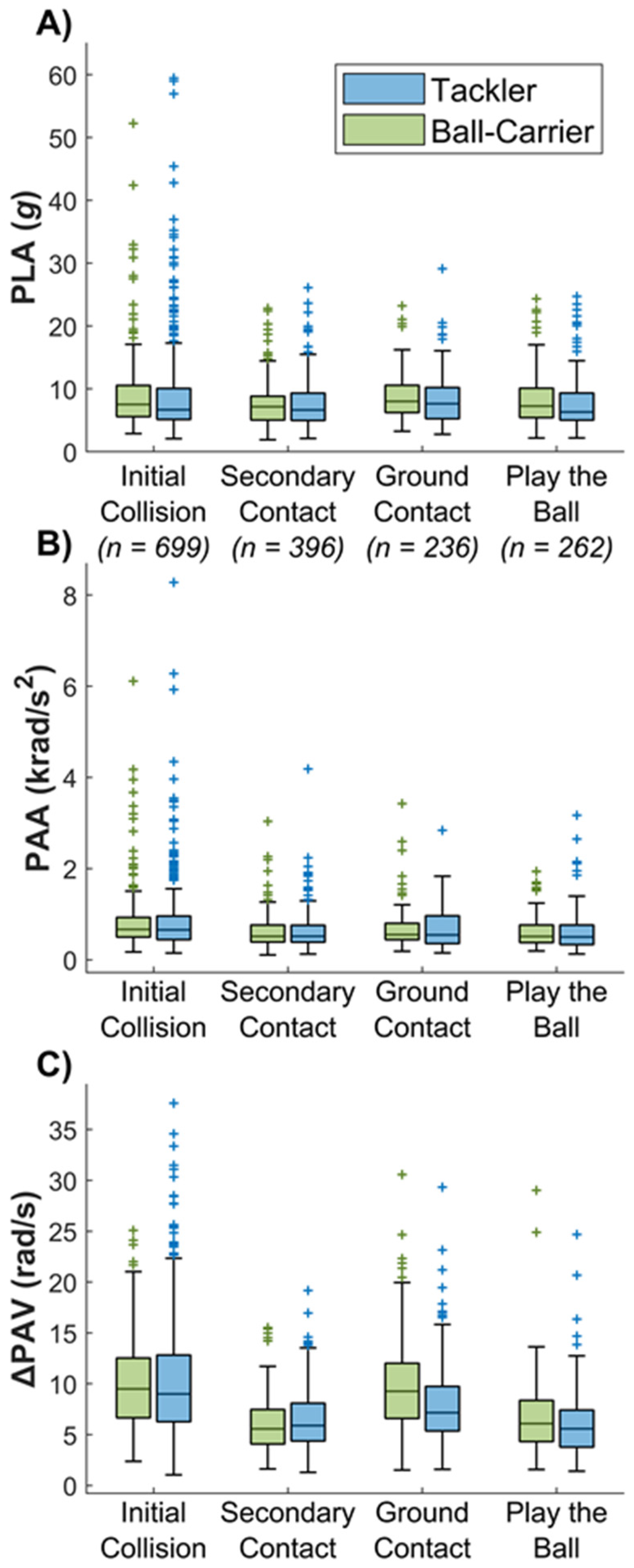Quantification of Head Acceleration Events in Rugby League: An Instrumented Mouthguard and Video Analysis Pilot Study
Abstract
:1. Introduction
2. Materials and Methods
Statistical Analysis
3. Results
4. Discussion
5. Perspective
Author Contributions
Funding
Institutional Review Board Statement
Informed Consent Statement
Data Availability Statement
Acknowledgments
Conflicts of Interest
References
- Naughton, M.; Jones, B.; Hendricks, S.; King, D.; Murphy, A.; Cummins, C. Correction to: Quantifying the Collision Dose in Rugby League: A Systematic Review, Meta-analysis, and Critical Analysis. Sports Med.-Open 2020, 6, 50. [Google Scholar] [CrossRef]
- Gabbett, T.J. Influence of training and match intensity on injuries in rugby league. J. Sports Sci. 2004, 22, 409–417. [Google Scholar] [CrossRef]
- Cunningham, J.; Broglio, S.; Wilson, F. Influence of playing rugby on long-term brain health following retirement: A systematic review and narrative synthesis. BMJ Open Sport Exerc. Med. 2018, 4, e000356. [Google Scholar] [CrossRef] [PubMed]
- Fitzpatrick, A.C.; Naylor, A.S.; Myler, P.; Robertson, C. A three-year epidemiological prospective cohort study of rugby league match injuries from the European Super League. J. Sci. Med. Sport 2018, 21, 160–165. [Google Scholar] [CrossRef]
- Gardner, A.; Iverson, G.; Levi, C.; Schofield, P.; Kay-Lambkin, F.; Kohler, R.M.N.; Stanwell, P. A systematic review of concussion in rugby league. Br. J. Sports Med. 2014, 49, 495–498. [Google Scholar] [CrossRef] [Green Version]
- King, D.; Hume, P.A.; Clark, T. Nature of Tackles That Result in Injury in Professional Rugby League. Res. Sports Med. 2012, 20, 86–104. [Google Scholar] [CrossRef]
- Gardner, A.J.; Iverson, G.L.; Stanwell, P.; Moore, T.; Ellis, J.; Levi, C.R. A video analysis of use of the new ‘Concussion interchange rule’in the national rugby league. Int. J. Sports Med. 2016, 37, 267–273. [Google Scholar]
- Tierney, G.J.; Kuo, C.; Wu, L.; Weaving, D.; Camarillo, D. Analysis of head acceleration events in collegiate-level American football: A combination of qualitative video analysis and in-vivo head kinematic measurement. J. Biomech. 2020, 110, 109969. [Google Scholar] [CrossRef] [PubMed]
- Viano, D.C.; Casson, I.R.; Pellman, E.J. Concussion in professional football: Biomechanics of the struck player—part 14. Neurosurgery 2007, 61, 313–328. [Google Scholar] [CrossRef] [PubMed]
- Guskiewicz, K.M.; Mihalik, J.P. Biomechanics of sport concussion: Quest for the elusive injury threshold. Exerc. Sport Sci. Rev. 2011, 39, 4–11. [Google Scholar] [CrossRef] [PubMed]
- Broglio, S.P.; Lapointe, A.; O’Connor, K.L.; McCrea, M. Head Impact Density: A Model to Explain the Elusive Concussion Threshold. J. Neurotrauma 2017, 34, 2675–2683. [Google Scholar] [CrossRef] [PubMed]
- Zhao, W.; Bartsch, A.; Benzel, E.; Miele, V.; Stemper, B.D.; Ji, S. Regional Brain Injury Vulnerability in Football from Two Finite Element Models of the Human Head; IRCOBI: Florence, Italy, 2019; pp. 619–621. [Google Scholar]
- Montenigro, P.; Alosco, M.L.; Martin, B.M.; Daneshvar, D.; Mez, J.; Chaisson, C.E.; Nowinski, C.J.; Au, R.; McKee, A.C.; Cantu, R.C.; et al. Cumulative Head Impact Exposure Predicts Later-Life Depression, Apathy, Executive Dysfunction, and Cognitive Impairment in Former High School and College Football Players. J. Neurotrauma 2017, 34, 328–340. [Google Scholar] [CrossRef] [PubMed]
- Wu, L.C.; Nangia, V.; Bui, K.; Hammoor, B.; Kurt, M.; Hernandez, F.; Kuo, C.; Camarillo, D.B. In Vivo Evaluation of Wearable Head Impact Sensors. Ann. Biomed. Eng. 2016, 44, 1234–1245. [Google Scholar] [CrossRef] [Green Version]
- Kieffer, E.E.; Vaillancourt, C.; Brolinson, P.G.; Rowson, S. Using In-Mouth Sensors to Measure Head Kinematics in Rugby; IRCOBI: Florence, Italy, 2020. [Google Scholar]
- King, D.; Hume, P.; Brughelli, M.; Gissane, C. Instrumented Mouthguard Acceleration Analyses for Head Impacts in Amateur Rugby Union Players Over a Season of Matches. Am. J. Sports Med. 2015, 43, 614–624. [Google Scholar] [CrossRef]
- Carey, L.; Terry, D.P.; McIntosh, A.S.; Stanwell, P.; Iverson, G.L.; Gardner, A.J. Video Analysis and Verification of Direct Head Impacts Recorded by Wearable Sensors in Junior Rugby League Players. Sports Med.-Open 2021, 7, 66. [Google Scholar] [CrossRef] [PubMed]
- Liu, Y.; Domel, A.G.; Yousefsani, S.A.; Kondic, J.; Grant, G.; Zeineh, M.; Camarillo, D.B. Validation and Comparison of Instrumented Mouthguards for Measuring Head Kinematics and Assessing Brain Deformation in Football Impacts. Ann. Biomed. Eng. 2020, 48, 2580–2598. [Google Scholar] [CrossRef]
- Kieffer, E.E.; Begonia, M.T.; Tyson, A.M.; Rowson, S. A Two-Phased Approach to Quantifying Head Impact Sensor Accuracy: In-Laboratory and On-Field Assessments. Ann. Biomed. Eng. 2020, 48, 2613–2625. [Google Scholar] [CrossRef]
- Cohen, J. A Coefficient of Agreement for Nominal Scales. Educ. Psychol. Meas. 1960, 20, 37–46. [Google Scholar] [CrossRef]
- Bates, D.; Mächler, M.; Bolker, B.; Walker, S. Fitting linear mixed-effects models using lme4. arXiv 2014, arXiv:1406.5823. [Google Scholar]
- Takhounts, E.G.; Craig, M.J.; Moorhouse, K.; McFadden, J.; Hasija, V. Development of Brain Injury Criteria (BrIC). SAE Trans. 2013, 57, 243–266. [Google Scholar] [CrossRef]
- King, D.; Hume, P.; Gissane, C.; Brughelli, M.; Clark, T. The Influence of Head Impact Threshold for Reporting Data in Contact and Collision Sports: Systematic Review and Original Data Analysis. Sports Med. 2016, 46, 151–169. [Google Scholar] [CrossRef] [PubMed]
- Miller, L.E.; Urban, J.E.; Whelan, V.M.; Baxter, W.W.; Tatter, S.B.; Stitzel, J.D. An envelope of linear and rotational head motion during everyday activities. Biomech. Model. Mechanobiol. 2020, 19, 1003–1014. [Google Scholar] [CrossRef]
- Wang, T.; Kenny, R.; Wu, L.C. Head Impact Sensor Triggering Bias Introduced by Linear Acceleration Thresholding. Ann. Biomed. Eng. 2021, 49, 3189–3199. [Google Scholar] [CrossRef] [PubMed]
- Tierney, G.; Weaving, D.; Tooby, J.; Al-Dawoud, M.; Hendricks, S.; Phillips, G.; Stokes, K.A.; Till, K.; Jones, B. Quantifying head acceleration exposure via instrumented mouthguards (iMG): A validity and feasibility study protocol to inform iMG suitability for the TaCKLE project. BMJ Open Sport Exerc. Med. 2021, 7, e001125. [Google Scholar] [CrossRef]
- Wu, S.; Zhao, W.; Rowson, B.; Rowson, S.; Ji, S. A network-based response feature matrix as a brain injury metric. Biomech. Model. Mechanobiol. 2019, 19, 927–942. [Google Scholar] [CrossRef] [PubMed]
- Bian, K.; Mao, H. Mechanisms and variances of rotation-induced brain injury: A parametric investigation between head kinematics and brain strain. Biomech. Model. Mechanobiol. 2020, 19, 2323–2341. [Google Scholar] [CrossRef]
- Tierney, G. Concussion biomechanics, head acceleration exposure and brain injury criteria in sport: A review. Sports Biomech. 2021, 1–29. [Google Scholar] [CrossRef]



| Characteristic | Cohen’s κ [20] | Definition |
|---|---|---|
| Contact Event | 1 | Tackle—HAE occurs whilst the tackler is attempting to impede the ball carrier Non-tackle—Any HAE occurring outside of a tackle (e.g., during celebrations, ball to head impacts). |
| Only tackle HAE were analysed for the following characteristics | ||
| Tackle Stage | 0.87 | Initial Collision—HAE occurs from the first collision made between ball carrier and each unique tackler in a tackle. Secondary Contact—HAE occurs after the initial collision between the same ball carrier and tackler has already been made and before the ball carrier is grounded. Ground Contact—HAE caused by players falling to the ground during a tackle; forces can be transmitted through player. Play the Ball—Any HAE which occurs after the ball carrier has been grounded before a new phase begins. |
| Impacted Player | 1 | Ball Carrier—Impacted player is in possession of the ball. Tackler—Impacted player is attempting to stop the ball carrier. |
| Head Loading Type | 0.82 | Direct—Head loading is through direct contact with the head. Indirect—Inertial head loading transmitted through the neck from an impact to the body. |
| Pairwise Comparison | PLA | PAA | ΔPAV | |||
|---|---|---|---|---|---|---|
| ES | p-Value | ES | p-Value | ES | p-Value | |
| Ball Carrier HAE | ||||||
| Initial collision vs. secondary contact | 0.3 | 0.003 | 0.5 | <0.001 | 0.97 | <0.001 |
| (small) | (small) | (moderate) | ||||
| Initial collision vs. ground contact | −0.07 | 0.516 | 0.29 | 0.024 | 0.03 | 0.818 |
| (trivial) | (small) | (trivial) | ||||
| Initial collision vs. play the ball | 0.14 | 0.202 | 0.47 | <0.001 | 0.79 | <0.001 |
| (trivial) | (small) | (moderate) | ||||
| Secondary contact vs. ground contact | −0.37 | 0.003 | −0.21 | 0.131 | −0.95 | <0.001 |
| (small) | (small) | (moderate) | ||||
| Secondary contact vs. play the ball | −0.16 | 0.197 | −0.04 | 0.792 | −0.18 | 0.134 |
| (trivial) | (trivial) | (trivial) | ||||
| Ground contact vs. play the ball | 0.21 | 0.106 | 0.18 | 0.245 | 0.77 | <0.001 |
| (small) | (trivial) | (moderate) | ||||
| Tackler HAE | ||||||
| Initial collision vs. secondary contact | 0.19 | 0.016 | 0.41 | <0.001 | 0.87 | <0.001 |
| (trivial) | (small) | (moderate) | ||||
| Initial collision vs. ground contact | −0.01 | 0.945 | 0.35 | 0.002 | 0.46 | <0.001 |
| (trivial) | (small) | (small) | ||||
| Initial collision vs. play the ball | 0.21 | 0.031 | 0.52 | <0.001 | 1.06 | <0.001 |
| (small) | (small) | (moderate) | ||||
| Secondary contact vs. ground contact | −0.2 | 0.068 | −0.05 | 0.659 | −0.41 | <0.001 |
| (small) | (trivial) | (small) | ||||
| Secondary contact vs. play the ball | 0.01 | 0.901 | 0.11 | 0.346 | 0.19 | 0.069 |
| (trivial) | (trivial) | (trivial) | ||||
| Ground contact vs. play the ball | 0.21 | 0.078 | 0.17 | 0.223 | 0.6 | <0.001 |
| (small) | (trivial) | (moderate) | ||||
| Ball carrier vs. tackler comparison for each tackle stage | ||||||
| Initial collision (ball carrier vs. tackler) | 0.13 | 0.116 | 0.09 | 0.311 | 0.01 | 0.947 |
| (trivial) | (trivial) | (trivial) | ||||
| Secondary contact (ball carrier vs. tackler) | 0.02 | 0.845 | 0 | 0.966 | −0.1 | 0.343 |
| (trivial) | (trivial) | (trivial) | ||||
| Ground contact (ball carrier vs. tackler) | 0.19 | 0.143 | 0.16 | 0.293 | 0.44 | <0.001 |
| (trivial) | (trivial) | (small) | ||||
| Play the ball (ball carrier vs. tackler) | 0.19 | 0.127 | 0.15 | 0.296 | 0.27 | 0.028 |
| (trivial) | (trivial) | (small) | ||||
| Head loading type | ||||||
| Direct vs. indirect | 0.35 | <0.001 | 0.16 | 0.004 | 0.62 | <0.001 |
| (small) | (trivial) | (moderate) | ||||
Publisher’s Note: MDPI stays neutral with regard to jurisdictional claims in published maps and institutional affiliations. |
© 2022 by the authors. Licensee MDPI, Basel, Switzerland. This article is an open access article distributed under the terms and conditions of the Creative Commons Attribution (CC BY) license (https://creativecommons.org/licenses/by/4.0/).
Share and Cite
Tooby, J.; Weaving, D.; Al-Dawoud, M.; Tierney, G. Quantification of Head Acceleration Events in Rugby League: An Instrumented Mouthguard and Video Analysis Pilot Study. Sensors 2022, 22, 584. https://doi.org/10.3390/s22020584
Tooby J, Weaving D, Al-Dawoud M, Tierney G. Quantification of Head Acceleration Events in Rugby League: An Instrumented Mouthguard and Video Analysis Pilot Study. Sensors. 2022; 22(2):584. https://doi.org/10.3390/s22020584
Chicago/Turabian StyleTooby, James, Dan Weaving, Marwan Al-Dawoud, and Gregory Tierney. 2022. "Quantification of Head Acceleration Events in Rugby League: An Instrumented Mouthguard and Video Analysis Pilot Study" Sensors 22, no. 2: 584. https://doi.org/10.3390/s22020584
APA StyleTooby, J., Weaving, D., Al-Dawoud, M., & Tierney, G. (2022). Quantification of Head Acceleration Events in Rugby League: An Instrumented Mouthguard and Video Analysis Pilot Study. Sensors, 22(2), 584. https://doi.org/10.3390/s22020584





